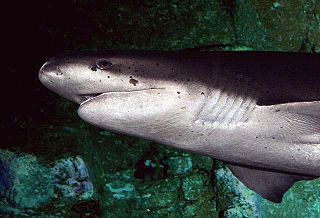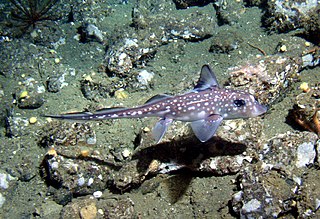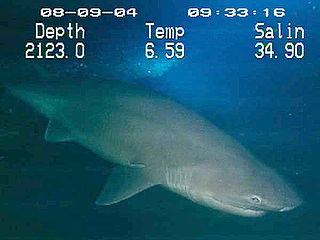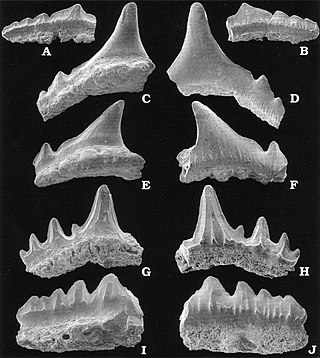
Carcharhiniformes, the ground sharks, are the largest order of sharks, with over 270 species. They include a number of common types, such as catsharks, swellsharks, and the sandbar shark.

The Hexanchiformes are a primitive order of sharks, that numbering just seven extant species in two families. Fossil sharks that were apparently very similar to modern sevengill species are known from Jurassic specimens.

The Lamniformes are an order of sharks commonly known as mackerel sharks. It includes some of the most familiar species of sharks, such as the great white, as well as more unusual representatives, such as the goblin shark and megamouth shark.

Chimaeras are cartilaginous fish in the order Chimaeriformes, known informally as ghost sharks, rat fish, spookfish, or rabbit fish; the last three names are not to be confused with rattails, Opisthoproctidae, or Siganidae, respectively.

Cow sharks are a shark family, the Hexanchidae, characterized by an additional pair or pairs of gill slits. Its 37 species are placed within the 10 genera: Gladioserratus, Heptranchias, Hexanchus, Notidanodon, Notorynchus, Pachyhexanchus, Paraheptranchias, Pseudonotidanus, Welcommia, and Weltonia.

Neoceratodus is a genus of lungfish in the family Neoceratodontidae. The extant Australian lungfish is the only surviving member of this genus, but it was formerly much more widespread, being distributed throughout Africa, Australia, and South America. Species were also much more diverse in body plan; for example, the Cretaceous species Neoceratodus africanus was a gigantic species that coexisted with Spinosaurus in what is now the Kem Kem Formation of Morocco. The earliest fossils from this genus are of Neoceratodus potkooroki from the mid Cretaceous (Albian-Cenomanian) Griman Creek Formation of Australia; remains from the Late Jurassic of Uruguay assigned to this genus probably do not belong to the genus.

The South Polar region of the Cretaceous comprised the continent of East Gondwana–modern day Australia, Zealandia, and Antarctica–a product of the break-up of Gondwana in the Cretaceous Period. The southern region, during this time, was much warmer than it is today, ranging from perhaps 4–8 °C (39–46 °F) in the latest Cretaceous Maastrichtian in what is now southeastern Australia. This prevented permanent ice sheets from developing and fostered polar forests, which were largely dominated by conifers, cycads, and ferns, and relied on a temperate climate and heavy rainfall. Major fossil-bearing geological formations that record this area are: the Santa Marta and Sobral Formations of Seymour Island off the Antarctic Peninsula; the Snow Hill Island, Lopez de Bertodano, and the Hidden Lake Formations on James Ross Island also off the Antarctic Peninsula; and the Eumeralla and Wonthaggi Formations in Australia.

Chlamydoselachus is a genus of sharks and the sole extant member of the family Chlamydoselachidae, in the order Hexanchiformes. It contains two extant and four extinct species. The most widely known species still surviving is the frilled shark. It is known as a living fossil, along with Chlamydoselachus africana, also known as the southern African frilled shark, which is only found along coastal areas of South Africa. The only two extant species of this genus are deep-sea creatures which are typically weakened in areas closer to the surface. While the two extant species are similar in external appearance, they differ internally.
Anomotodon is an extinct genus of shark related to the extant goblin shark. The distribution of Anomotodon fossils is worldwide, in formations indicating that members of the genus lived from the Early Cretaceous epoch through the Eocene epoch, and perhaps through the Oligocene as well. Described species include A. novus, A. plicatus, A. principalis, and A. multidenticula.
Meristodonoides is an extinct genus of hybodont. The type species is M. rajkovichi, which was originally a species in the genus Hybodus. The species, along with other Hybodus species such as H. butleri and H. montanensis, was reassigned to Meristodonoides by Charlie J. Underwood and Stephen L. Cumbaa in 2010. The species is primarily known from remains from the Cretaceous of North America, spanning from the Aptian/Albian to Maastrichtian, making it one of the last surviving hybodont genera, though records of the genus likely extend back as far as the Late Jurassic, based on an undescribed skeleton from the Tithonian of England, and fragmentary teeth from the Kimmeridgian of Poland, England and Switzerland. Other remains of the genus are known from the Coniacian of England, and the Aptian-Albian of France. The morphology of the teeth suggests an adaptation to tearing prey. Fossils from the Western Interior Seaway suggest that it preferred nearshore marine environments, being absent from deeper-water areas, with it likely also being able to tolerate brackish and freshwater conditions.
Roulletia is an extinct genus of sand sharks. It was described by Romain Vullo, Henri Cappetta, and Didier Néraudeau in 2007, and the type species is R. bureaui, which existed during the upper Cenomanian of what is now France. The genus was named after its type locality, Roullet-Saint-Estèphe, while the species epithet honours Michel Bureau, an amateur paleontologist who gathered the material for the species. Another species, R. canadensis, was described from the Cenomanian of Canada by Charlie J. Underwood and Stephen L. Cumbaa in 2010. The species epithet refers to the country in which it was discovered. It has been suggested tentatively this genus may be related to Haimirichia, which has been placed in its own family (Haimirichiidae) based on soft-tissue preservation.

Cretalamna is a genus of extinct otodontid shark that lived from the latest Early Cretaceous to Eocene epoch. It is considered by many to be the ancestor of the largest sharks to have ever lived, such as Otodus angustidens, Otodus chubutensis, and Otodus megalodon.
This list of fossil fishes described in 2013 is a list of new taxa of placoderms, fossil cartilaginous fishes and bony fishess of every kind that have been described during the year 2013. The list only includes taxa at the level of genus or species.

Synechodontiformes is an extinct order of prehistoric shark-like neoselachians, known from the Permian to the Paleogene. They are considered to be members of Neoselachii, the group that contains modern sharks and rays.

Paracestracion is an extinct genus of heterodontiform sharks from Early Jurassic to Early Cretaceous-aged rocks of England, France, Germany and Luxembourg. The genu was first described in 1911 by Ernst Hermann Friedrich von Koken in Karl Alfred von Zittel.
Acrorhizodus is an extinct genus of hybodont shark currently containing only the species: Acrorhizodus khoratensis. It is known from the Albian to Aptian aged Khok Kruat formation of the Khok Pha Suam locality near the town of Sri Muang Mai, Thailand. It displays a mix of features which sets it apart from all hybodont families currently known.

Pseudorhina is an extinct genus of stem angel shark seemingly restricted to the Mesozoic of Europe. It is represented by several articulated individuals as well as isolated teeth. There are four species.

Egertonodus is an extinct genus of shark-like hybodont fish. It includes E. basanus from the Jurassic of Europe and North Africa and Cretaceous of North America, North Africa and Europe, and E. duffini from the Middle Jurassic of England. Indeterminate remains of the genus have been reported from the Early Cretaceous of Asia. E. basanus is known from preserved skull material, while E. duffini is only known from teeth. The genus is distinguished from Hybodussensu stricto by characters of the skull and teeth. E. basanus, the most common species, is thought to have reached 1.5 m in length. E. fraasi from the Late Jurassic of Germany, known from a poorly preserved full body fossil, was placed in Egertonodus in one study, but this has been subsequently questioned by other authors, due to strong differences in tooth morphology from the type species. Fossils have been found in freshwater and lagoonal environments.
Rolfodon is an extinct genus of shark in the family Chlamydoselachidae. It is closely related to the extant frilled sharks in the genus Chlamydoselachus, which it can be differentiated from by tooth morphology. It is named after late Canadian paleontologist Rolf Ludvigsen.
Xampylodon is an extinct genus of cow shark. Fossils assigned to this genus are known from the Late Cretaceous and early Paleocene. Xampylodon was recently erected after a revision on the taxonomy of hexanchid fossil teeth, and includes three species previously included in Notidanodon.












